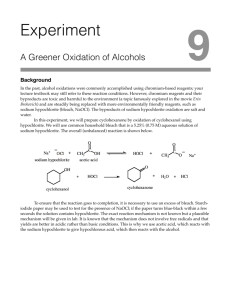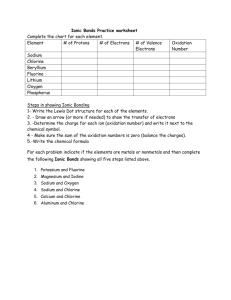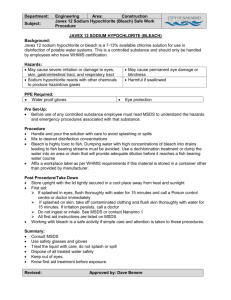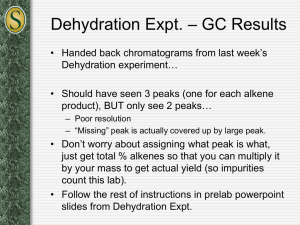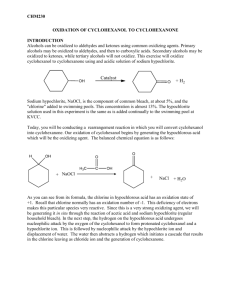Sodium Hypochlorite Oxidation of Alcohols
advertisement
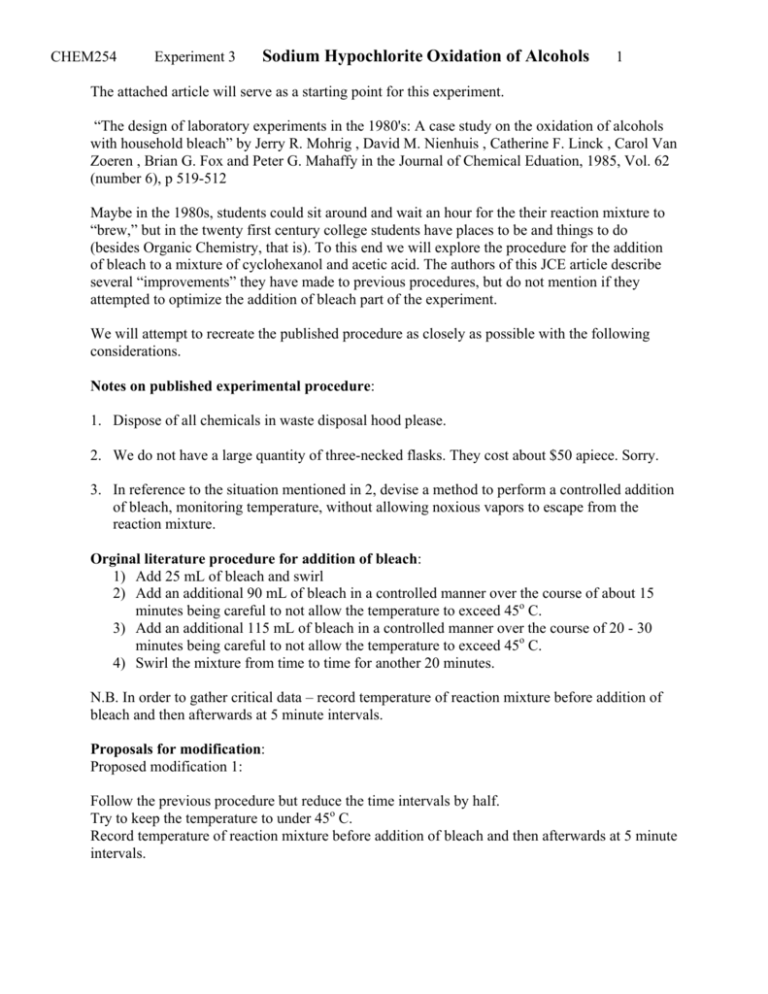
CHEM254
Experiment 3
Sodium Hypochlorite Oxidation of Alcohols
1
The attached article will serve as a starting point for this experiment.
“The design of laboratory experiments in the 1980's: A case study on the oxidation of alcohols
with household bleach” by Jerry R. Mohrig , David M. Nienhuis , Catherine F. Linck , Carol Van
Zoeren , Brian G. Fox and Peter G. Mahaffy in the Journal of Chemical Eduation, 1985, Vol. 62
(number 6), p 519-512
Maybe in the 1980s, students could sit around and wait an hour for the their reaction mixture to
“brew,” but in the twenty first century college students have places to be and things to do
(besides Organic Chemistry, that is). To this end we will explore the procedure for the addition
of bleach to a mixture of cyclohexanol and acetic acid. The authors of this JCE article describe
several “improvements” they have made to previous procedures, but do not mention if they
attempted to optimize the addition of bleach part of the experiment.
We will attempt to recreate the published procedure as closely as possible with the following
considerations.
Notes on published experimental procedure:
1. Dispose of all chemicals in waste disposal hood please.
2. We do not have a large quantity of three-necked flasks. They cost about $50 apiece. Sorry.
3. In reference to the situation mentioned in 2, devise a method to perform a controlled addition
of bleach, monitoring temperature, without allowing noxious vapors to escape from the
reaction mixture.
Orginal literature procedure for addition of bleach:
1) Add 25 mL of bleach and swirl
2) Add an additional 90 mL of bleach in a controlled manner over the course of about 15
minutes being careful to not allow the temperature to exceed 45o C.
3) Add an additional 115 mL of bleach in a controlled manner over the course of 20 - 30
minutes being careful to not allow the temperature to exceed 45o C.
4) Swirl the mixture from time to time for another 20 minutes.
N.B. In order to gather critical data – record temperature of reaction mixture before addition of
bleach and then afterwards at 5 minute intervals.
Proposals for modification:
Proposed modification 1:
Follow the previous procedure but reduce the time intervals by half.
Try to keep the temperature to under 45o C.
Record temperature of reaction mixture before addition of bleach and then afterwards at 5 minute
intervals.
CHEM254
Experiment 3
Sodium Hypochlorite Oxidation of Alcohols
2
Proposed modification 2;
Mix the bleach “straight away” and let sit for 30 minutes.
Try to keep the temperature to under 45o C.
Record temperature of reaction mixture before addition of bleach and then afterwards at 5 minute
intervals.
In lab analysis:
Obtain the IR spectrum of the product.
Data entry:
Record the yield in grams of product and your temperature data points at time = 0, 5, 10, 15, 20,
30, 35 min, … on a spreadsheet before leaving lab.
Submission for GC-FID and NMR analysis.
Hand in a sample of your product in a properly labeled vial: Your name, date, vials contents, and
your experimental procedure (original, #1, or #2).
Checklist for completing the "Prelab" section:
(refer to Laboratory Syllabus for complete directions)
Title and Purpose.
____Physical constants. (2 points) Create a table of physical constants, solubility and safety data
for the chemical compounds referred to in the procedure.
____ Structures and equations. (1 point) Write (using chemical structures) the balanced equation
for this reaction. Hint: water is a product.
___ Flowchart. (1 point) Refer to "Procedure" Your assigned procedures: orginal:
(1R,2R,3R,4R,5R,6R,7R,8R)
modification 1: (1L,2L,5L,7L,8L) or modification 2 (3L,4L,6L,9,10)
___ Calculations. (2 points)
1) Determine the number of moles of acetic acid used.
2) Determine the number of moles of NaOCl used. Use 5.25g/100 mL NaOCl in Clorox.
3) Calculate the theoretical yield (in grams) of cyclohexanone.
Article:
_____ (1 point) According to the authors, what are the three advantages of using (sodium)
hypochlorite rather than Cr(IV)?
____ Safety Question: (1 point) Consult the MSDS for Clorox <http://www.biosci.ohiostate.edu/safety/MSDS/CLOROX%20LIQUID%20BLEACH.htm> What Emergency/First Aid Procedures
are advised if the product is splashed into one’s eyes?
CHEM254
Experiment 3
Sodium Hypochlorite Oxidation of Alcohols
3
Experimental Observations and Data:
Hand in a copy of your experimental observations and data before you leave lab.
Experimental Observations.
Refer to last semester and laboratory syllabus.
Lab Report Checklist:
Results.
____ Which experimental procedure did you use (original #1, or #2)?
____ (1 point) % yield of product Æ product mass x 100/theoretical yield. Show your
calculations.
____ (1 point) Interpret the IR spectrum of your product. Did you obtain the desired product?
How pure is it?
____ (1 point) Interpret the GC-FID chromatogram of your reaction mixture (GC-FID of
standards may be obtained on the CHEM254 MyDU website.) Did you obtain the desired
product? How pure is it?
Discussion and Conclusion.
Interpret the results of the class data. (2 points)
What are the issues that need to be addressed? (For example, is it sufficient to compare reported
yields or are there other aspects of the experiment that should be addressed?)
What conclusions can be drawn?
What should next year’s students do to continue to explore this intriguing reaction? (1 point)
Write a Journal of Organic Chemistry style abstract of this experiment including class data.
(2 points)
JOC website: http://pubs.acs.org/journal/joceah
Sample article with abstract: http://pubs.acs.org/doi/pdf/10.1021/jo101791w
The Design of Laboratory Experiments in the 1980's
A Case Study on the Oxidation of Alcohols with Household Bleach
Jerry R. Mohrig, David M. Nienhuis, Catherine F. Linck, Carol Van Zoeren, and Brian G. Fox
Carleton College, Northfield, MN 55057
Peter G. Mahaffy
The King's College, Edmonton, Alberta, Canada T5H 2M1
Chemists know that lahoratory experiences are an important component of undergraduate education in chemistry.
This is stated once again in the new Criteria and Evaluation
Procedures booklet from the ACS Committee on Professional
Training. However, teaching laboratories are expensive to
operateind administrators may question the necessity of so
many lahoratory hours. We need to he clear on the .
goals and
strategies in our laboratory courses.
Experiments must teach sound chemical principles, careful
observation, and useful experimental techniques. They should
be designed to catch students' interest, transporting them
from passive spectators to active participants. Whenever
possible, lahoratory work should involve the commonplace
and the fundamental. Experiments should relate to the
common experience of students as well as to fundamental
chemistry.
In the iast few years undergraduate laboratory courses have
faced new rhallenees-inflation and increased e m ~ h a s i son
lahoratory safety and the disposal of hazardous wastes. An
ideal experiment is inexpensive and safe and produces innocuous wastes. The use of some of the classic experiments
in the organic chemistry laboratory must be re-evaluated in
the light of these criteria.
One experiment, found in virtually all organic chemistry
laboratory programs, is the oxidation of an alcohol with
chromium(VI). The oxidation of alcohols to ketones relates
and is an imtwo of the most imnortant functional uerouos
.
portant reaction in organic synthesis. Chromic acid has been
used in introductory chemistry labs since the 1940's. Probably
the most popular experiment is the oxidation of cyclohexanol
to cyclohexanone, using sodium dichromate in an acidic medium. The oxidation occurs in reasonable yield and provides
a good introduction to the use of infrared sDectroscoDv
."for
fuhctiona~group analysis ( 1 ) .
In the summer of 1980 Stevens, Chapman, and Weller reported that "swimming pool chlorine" reacts with secondary
alcohols to give ketones in good yield (2).Brief notes, adapting
this method for use in the undergraduate laboratory, suhsequently appeared in THIS JOURNAL
(3).
What are the advantaees of usine hwochlorite
rather than
..
Cr(V1) oxidation of an alcohol? First, oxidations with hypochlorite present no hazardous waste disposal problem. The
end
are chloride and the desired ketone; no toxic
metal ions are present. Chromic acid oxidations pose a severe
waste disposal problem, because chromium in any soluble
form cannot he put down the drain in some states. Chromium(III), produced in the oxidation of a secondary alcohol, is
toxic to fish and invertebrate snecies ( 4 ) . Its acute toxicitv
depends upon water hardness. i t 100 &L Ca('O3, the con'.
centration of Cr(l11)should not exceed .1.7 me,L. The chronic
toxicity of Cr(I1I) to freshwater aquatic lif;? occurs a t concentrations as low as 4.4 &g/L.
Second. the hv~ochloritereaction offers substantial safetv
advantag& compared to chromic acid oxidation. chromium
trioxide and its salts have a corrosive action on the skin and
mucous membranes. For 1981, the time-weighted average
(TWA) concentration limit of Cr(V1) compounds in the air
was 0.05 mg/m3 (milligrams of compound per cubic meter of
air) (5). Fortunately, neither chromium trioxide nor sodium
dichromate dihydrate is very volatile. Within the last few years
some Cr(V1) compounds have been indicted as carcinogens
(6).Even though the atmospheric levels of Cr(V1) compounds
in anv teaching situation would he very low, this must be
viewed as a disidvantage. C'onrentrated sulfuric arid, ramrnonly used in CrrVl) oxidations, is also hazanlnus. The only
appreciable safety concern in the hypochlorite oxidation is
chlorine gas which must be contained effectively; more ahout
this later.
The rising cost of common chemicals has prompted most
chemistry teachers to reconsider common practices. The costs
of sodium dichromate and chromium trioxide have risen
dramatically in recent years. At current prices one can estimate a cost of $0.25 per student for the sodium dichromate
alone in the Cr(V1) oxidation of 16 e of cvclohexanol.
Waste disposal, saiety, and cost &siderations associated
with the Cr(V1Joxidation ~roceduresvrovided the imlwtus
for our exploration of sod& hypochl&ite as an alternative
oxidant.
The Stevens article reports the hypochlorite oxidation of'
10 alcohols in iso1atL.d yields of 8.%96"; wnh acetic acid as the
solvent. We adapted this procedure for our introductory organic chemistry lahoratory, using "swimming pool chlorine"
(12.5%hv
" weieht)
- . to oxidize cvclohexanol to cvclohexanone.
but encountered several problems. First, the large volumes
of solvent (3-6 mL AcOHIgram of alcohol) and the ether used
in multiple extractions made the experiment too expensive
for classroom use. Second, "swimming pool chlorine" had a
number of drawbacks. Storage of "swimming pool chlorine''
causes its concentration to decrease by about 20% per month;
therefore, a titration was necessary before its use. Since we
found it availahle only in 5-gal containers, there was suhstantial waste in small to medium-sized classes. A more severe
disadvantage was the modest chlorine odor apparent
in the
..
lahoratory from time to time. Although Clz concentrations
never exceeded the maximum recommended ACGIH shortterm exposure level (3 ppm) (5),the odor was quite unpleasant
a t this level.
T o address these problems, we significantly altered the
oxidation procedure in three ways. We found household
bleach, a 5.25% (0.74 M ) solution of sodium hypochlorite
availahle at most grocery stores, to function even better than
"swimming pool chlorine" as the oxidant for cyclohexanol.
Yields were comparable to slightly better and atmospheric Clz
concentrations were diminished considerahlv. The atmospheric Clz level was less than 0.2 ppm and was not detectable
~hvsioloeicallv
."
" in lahoratories in which 20 undereraduates
"
were working. Bleach is available inexpensively in half-gallon
and gallon containers and standard brands do not reauire tit r a t i k Recently, the use of hypochlorite bleach has been
reported for the oxidaton of secondary alcohols (7).
Volume 62
Number 6
June 1985
519
Second, we found no need for the large amounts of acetic
acid renorted bv Stevens and others: 0.5 mL AcOH/e alcohol
is suffi'cient. ~ k i point
s
will be considered later in-the discussion of the reaction nathwav.
Third, we found ether extractions unnecessary when the
acetic acid is neutralized with sodium hydroxide followed by
a steam distillation of the cyclohexanone.
Class testing of this revised oxidation procedure by several
hundred undergraduates in first-term organic chemistry
laboratories showed that 50-60% vields of cvclohexanone are
common. GLC analysis revealedthat two-thirds of the students ohtained cyclohexanone of >95% purity. Both Chlorox
and Hilex brands of bleach worked equally well. The oxidation
of 16 g of cyclohexanol by hypochlorite hleach works best;
using smaller amounts produces unacceptable product losses
on the semimicro 19/22 J glassware. Higher yields (>75%)
were ohtained when extractions were used; dichloromethane
is an effective extraction solvent. We chose not to use the extraction sten in order to avoid anv, oreanic
.. waste orodnct.
Neutralization of the acetic acid is newsiary to avoid it5 codistillation in thesteamdistillstionnithe product.Addition
of a it:w drops ot an acid-hase indirator makes the visualization 1d ihe neutralization step cnlorful and straightforward.
.At current prices the chemicals fm the rntire experiment
cost about SU.:lS per student. Therefore, oxidation of a secondary alcohol with hypochlorite is somiwhat less expensive
than the Cr(V1) oxidation.
In addition to the cyclohexanol oxidation, we have used the
same procedures for the synthesis of camphor from borne01
and 2-octanone from 2-octanol. Both of these ketones are
natural products. Camphor has many medical and industrial
uses. Its fragrant
and nenetratine odor is familiar to most
"
students. These two oxidation reactions can serve as excellent
variants for adventuresome students and teachers.
Historical Interlude and Reactlon Mechanism
With all of the advantages of positive chlorine as an inexpensive, safe oxidant, it is somewhat surprising that it has not
been a traditional reagent for the transformation of secondarv
alcohols to ketones. he oxidation of methyl ketones by means
of alkaline hypohalite, known to generations of organic
chemistry students as the haloform reaction, was first reported
by Liehen in 1822 (8). One can only speculate why i t took until
1980 to annreciate
the eeneralitv of the aaueous hvoochlorite
..
-.
oxidation of secondary alcohols. In part, the delay may have
resulted from the nerceived lack of a convenient chlorine
source, since the generation and handling of chlminegas can
be awkward. The svnthsic and use uf teri-l~utvl
. hv~ochlorik.
..
another trnditiona.~oxidant, is both inconvenient and poten:
tiidly unsafe,. In tht: last drrade Corey (9)and others (10) have
developed the usr nf nmplexes crt'('l? with dimethyh~~lfuxide,
r o u s Thesr
dialksl sulfides, and h e x u ~ n e t h v l p l i ~ ~ ~ h r ~triumide.
offer-a number of advantagesbk are not suitable for largescale use in the teaching laboratory.
Neglect nistdium hg;wchlnrite fnr oxidizing alcohols may
have also resulted from the lack of appreciationof the role cf
acid in the reaction. Many kinetic studies have been carried
out on the oxidation of alcohols with BrzIH20, but this reaction has a different acidity dependence than when chlorine
520
Journal of Chemical Education
is the oxidant (11). Alkaline aqueous solutions of sodium
hypochlorite will not oxidize alcoholswithout additional
catalysts; for example, RuCI3 and phase-transfer catalysis
have been renorted 112.131.
. . . At low nH.
. , molecular chlorine is
a ma.ior component of the aqueous hypochlorite system. Alkali
meatlv increases the solubilitv of Cb bv convertine i t to
chlorihe and hypochlorite; th; pH ofbleach is abo; 12.5.
Disproportionation and evolution of oxygen are slow a t room
temperature, so one can produce stable solutions of hypochlorite.
Not a great dcal is knoumn ahout the mechanism of the hvporhlorite oxidntion of alcohols. Presurnnl~lg,hypochlorous
acid must br present for the reaction to proceed. Kudes~nand
Mukherjee have pngpoinl that molecular rhlorine is the actual
nxidant and the alkyl hypochlorite ester is an intermediate
(1.11. Their kinetic studies on the oxidation 18f 2-prnpannl with
chlorine pnwidr the most detailed mechanistjc studies
a\,ailahle. If an alkyl h\lx~chlnritcis nn intermediate, one could
envisage a simple E2 elimination lending to the ketone
( 1 5 I.
One expects that the mechanism of hv~ochloriteoxidation
of alcohois will he unraveled more compieiely in time, through
the use of some of the elegant experimental techniques that
have been applied to Cr(V1) oxidations.
Our research has shown that the presence of molecular
oxygen, hydroquinone, or galvanoxyl does not affect the hypochlorite oxidation. Therefore, free-radical chain reactions
would seem to he unimportant in the oxidation.
Our kinetic studies on the acid dependence were done primarily with 2-propanol, which allows a homogeneous reaction
mixture. Reaction aliquots were quenched with excess acidified iodide and the usual thiosulfate titration carried out.
Reagent-grade sodium hypochlorite was the oxidant. The
reactions were carried out under flooding conditions. where
the concentration of 2-propnnol was 20-.lij times great& than
that oithe hwochlorite.The reaction wasshown to he firstorder in oxidabt. The pH was held constant a t 25' with sodium pyrophosphate (pH 9.9 and 7.8) and sodium acetate (pH
4.1) buffers. The reaction of hypochlorite with 2-propanol was
very slow at pH 9.9; only 6% reaction occurred in 12 h. At pH
7.8 it was 83% complete in 15 min, whereas a t pH 4.1 it was
83% complete in 5 min. Probably, any pH less than 7 will
provide a facile oxidation pathway. The pH dependence may
reflect the need for hypochlorous acid. At pH 8.0,24% of the
total chlorine is oresent as hvnochlorous
acid:, a t .
DH6.5.91%
".
is present as hypochlorous acid (8).Since acid is produced in
the oxidation itself, care must he taken in studying the acid/
rate relationship. We also confirmed earlier reports that metal
chlorides can catalyze the oxidation (14).
Oxidation of a secondary alcohol seems to proceed faster
than chlorination a t the a-carbon of the related ketone in a
weakly acidic environment. Both "swimming pool chlorine"
and hypochlorite hleach produce good yields of unchlorinated
ketones (2,3,16). The ring of cyclohexanone can be cleaved
and adipic acid produced with alkaline hypohalite solutions
(a), alt&ugh weohserved no ring cleavage under our reaction
conditions.
The Experiment
Caution: NaOH is caustic. Exercise care in its use. Glacial acetic
acid is an excellent dehydrating agent and can cause burns. If either
gets on the skin, wash it off immediately with cold water. Acetic acid
fumes are also irritating, so the acid should he poured in the h o d . The
same is true for the bleach solution. Chlorine eas is a resoiratorvand
eye irritant. Its acceptable short term atmospheric exposure level is
3 ppm. Cyclohexanol and cyclohexanone are moderate irritants; the
acceptable 8-h average atmospheric exposure limit for cyclohexanol
is 50 ppm; far cyclohexanoneit is 25 ppm. The acceptable short-term
exposure level for cyclohexanone is 100 ppm. Small quantities of excess sodium hypochloriteshould be disposed of in a fume hood by slow
addition to a large volume of concentrated reducing agent (sodium
bisulfite or sodium thiosulfate). When reaction is complete, adjust
the pH to 7 and flush down the drain with large amounts of water
-
117).
' Pour 16 mL (0.15 mol) cyclohexanol into a three-necked 500-mL
round-hottomed flask. Add 8 mL glacial acetic acid. Place a condenser
in one neck of the flask, a 125 mL dropping funnel in another and a
thermometer in the third opening. If the laboratory is well ventilated
or the experiment is being carried out in a hood, the apparatus is
complete. (Without good ventilation, put a piece of glass woolin the
bottom of a drvine tube and Dour in -2 cm of sodium hisulfite. This
tube attached.)
Grease the stopcock in the 125mL dropping funnel, and take it to
the hood to put in 115mL of the hleach solution. When uourinp the
bleach, use rubber gloves and dispense the solution wrefdly. stopper
the dropping funnel in the hood, then carry it hack to the bench with
a large beake~underneath it, and return it to your three-necked flask.
Put a small piece of paper between the stopper and the neck of the
dropping funnel so the solution will drop evenly. Make available an
ice bath with about 250 mL of ice in case the reaction gets too hot.
Add about 25 mL of the bleach solution to the reaction vessel. Swirl
the vessel to mix the reagents together. Then start adding the rest of
the sodium hypochlorite solution, swirling the flask from time to time
during the addition so that the reactants remain well mixed. The rate
of addition will be determined bv the tem~eratureof the solution. hut
iho~~ld
tnkc n., Ismgtr than 15 mm. Ideally, rhr marlmum tmmprrature
should not exceed 4.5'; 111-50" IS fine,howwcr. l l c r the ire bath if t he
rrartivn trmprrature e x c t r d ~15". I t the rrccrwn is kept too culd
(<40°), the product yield may he low.
After all the sodium hypochlorite has heen added, remove the
dropping funnel, temporarily stopper the reaction flask and obtain
another 115 mL of bleach solution in the dropping funnel. Add this
to the reaction mixture, keeping the temperature at 45'. Addition of
the total 230 mL of bleachshould take about 20-30min. In theearly
stages of the reaction, one can see the color of the chlorine disappear
as it reacts. Near the end of the additian,the yellow color should linger.
After addition is complete, remove the dropping funnel and stopper
the neck of the flask. Swirl the mixture from time to time for another
20 min.
Test for Excess Oxidant
OC1-
+ HSOs-
-
bisulfite
CI-
+ HSOIbisulfate
Wet a piece of starch-iodide indicator paper (if the bleach is too
concentrated, colorless iodate may form) and put a drop of aqueous
solution from the reaction vessel onto it. If excess oxidant remains,
the blue color of the triiodide-starch complex will appear. If you get
a blue color. add 2 mL saturated NaHSO- solution to the reaction
will have to he collected to recover all of the product. Since it is
somewhat water soluble, do not collect too much distillate. Cyclohexanone forms the top layer in the receiving flask.
Add 10 g solid sodium chloride to the distillate in order to decrease
the solubility of cyclohexanonein the aqueous layer. Stir the mixture
until almost all of the salt dissolves. Separate the layers and purify
the crude product by dryingit for 20min over 2 ganhydrousmagnesium sulfate or potassium carbonate.
Options and Comments
If the bleach has been stored for manv months. one mav
want to increase the quantity by 5%; it is present in just over
10%stoichiometric excess in our procedure. Extraction with
30 mL of CHzClz before drying will increase product yield for
two reasons-it will recover more of t h e ketone t h a t is dissol\wl in the wnwr and it will facilitate filtration of the drying
agent. Hou,ever, using CH,CI, adds a distillation step. Analysis of the product can be accomplished by GLC or infrared
spectroscopy (1 ).
There are many interesting open-ended options possible
with this experiment. Numerous secondary alcohols can be
e simnle enough
substituted for cvclohexanol. T h e ~ r o c e d u r is
"
t h a t students can design their own experimental variations
after looking up the physical properties of t h e secondary alcohol and the related ketone. T h e proper amount of sodium
bisulfate can be substituted for acetic acid and the neutralization step omitted. Isopropyl alcohol can be used in place
of sodium bisulfite to destroy t h e excess oxidant (16): any
remaining acetone can be removed easily by distillation.
T h e oxidation of secondary alcohols with common hypochlorite bleach provides a safe, environmentally sound, and
inexpensive modern synthetic method. It utilizes a varietv of
laboratory techniqt~&and some t ' u n d ~ m e n t ~oxidationl
reduction rhe~nistry.The rxperiment pruvides on opportunity
for the student t o review chemistry described in mbst intriductory chemistry courses. It offers some pretty colors and
uses a n oxidant known t o virtually everyone. ~ u m e r o u exs
perimental options are available within t h e experiment.
Acknowledgment
Our thanks en t o Jean Mohrie and Richard Ramette for
helpful suggestl'ons and to the many Carleton undergraduates
who performed variations of t h e experiment.'A Curricular
Research and Development Grant from Carleton College t o
J R M and PGM helped to support part of this work.
Literature Cited
I l l Mohrig, J. R., snd Neckers. D. C., "Laboratory Experiments in Organic Chemistry."
3rded..D.Vsn Nmtrand,New York, 1979,Chap.21.
(21 Stevens, R.V.,Chapman, K. T.,and Weller. H. N., J. Org. Chem.,45,2030(19S01.
(31 ialZuerek,N. M.,sndFurth,P.S.J. CHEM.EDUC.,58.824(1981): (bl Kauffman, J.
M.,andMcKee, J. R.,J.CHEM.
EPuC.59.862 (1982J.
I41 "Ambient Water Quality Criteria for Chromium," U.S. Environmental Protedion
Agency, Criteriaand Standards Div., Washington, DC. 1980.
(51 "Threshold Limit Values for Chemical Subslancer in Workroom Air," American
conrennce of Governments1 Industrial Hygienists (ACGLHI, Cincinnati, 1981.
(61 "OccupationalExposure toChromium (VII."HEW Publ. No. INLOSHl76-129,U.S.
Government Printing Office, Washington, DC 1375.
(71 (a1 Nwaukwa,S. 0. and Keehn,P. M., TatmhrdronLali.,23,35 119821:(bl Peckins,
R.A..andChau. F.,J.CWaM.Eouc.. 59.961 (19821.
181 Chskrsbsrtfy,S. K.,in '"Oxidation in OrganicChcmirfry."lEdilor:Trahsnovsky, W.
S.I. Academic Press, Now York. IWR, Part C, Chnp. V.
(aJC0rey.E.J.,andKim,C.U.,J.Amer.Chrm.Soc.,94,758611972):IblCorey,E.J.,
and Kim,C.U. T s t r o h e d r o n L e r t . 9 ~ 9119731.
(101 A1 Neirabeyeh. M., Ziegleh J.-C.,Gross,B., and Cauhere. P., Synthesis, 811 119761.
I91
Remove the thermometer and condenser. Rinse them, as well as
the dropping funnel, immediately with water and then sodium bisulfite solution. Add 2 mL thymol blue indicator solution to the reaction mixture. Then over a 3-min period add 6 M NaOH (about
3040 mL) through a short-stemmed funnel until the solution is
neutral (color change to blue). Swirl the flask gently at times during
the addition of base.
Distill the reaction mixture using a short-path column; cyclohexanone and water will codistill. Approximately 70-80 mL of distillate
1111 la1 Barker, I. R. L.,Chem. ind. ILondnnI. 1936 11964k (bl Perlmutter-Hayman. B..
and Weissmann. Y.. J. Amcr Chem Soc., 81.668 119691.
1121 Wolfe, S.,Hasan,S. K..sndCampbell.J.R., J. Chem. Soc. D. 1420 (19701.
(131 Lee, G. A., and Freedman, H. H., Tetrahedron Lett., 1641 (19761.
1141 Kudesis, V. P.,and Mukhorjee,S. K.,lndion J. Chsm., l5A.513 (19771.
1151 Kude6a.V. P.,andSharma,B. K..lndion J. Chem., 19A.82 (19801.
1161 Steuens,R. V.,Chapmsn, K.T., Stubbs,C.A..Tam, W. W.,and Albizatl, K. F.,Telrohrdron Lett., 23.4647 119821.
1171 Armour. M. A,, Browne, L. M.. and Weir, G. L., "HazsrdousChemiesla Information
and Disposal Guide."University of Alberta, Edmonton. IOSZ, p. 216.
Volume 62
Number 6
June 1985
521
